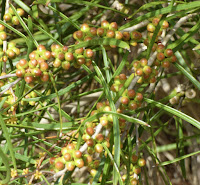I always thought an arboretum was a forest of different trees planted for our pleasure. But I now know I was misinformed, and an arboretum is actually a place where trees are grown for scientific and educational purposes. After recently visiting the Currency Creek Eucalypt Arboretum on one of its occasional open days, I also learnt a whole lot more about the many eucalypt species we have in Australia and just what happens at this particular arboretum.
To put you in the picture, I'll summarise the information on the sign erected at our meeting spot.
The arboretum is a specialist eucalypt arboretum and is privately owned, self-funded and managed by Dean Nicolle and his partner Annett Boerner. Its main purpose is research into Australia's eucalypts (genera Angophora, Eucalyptus and Corymbia). It has the largest collection of eucalypt species in the world, with over 900 species. There are over 8,000 individual trees planted on the site.
A substantial crowd had turned up. Dean introduced himself and set about explaining the purpose of the arboretum. He was a wonderful guide, explaining scientific information clearly, showing us examples, and giving us time to ask questions - and also warning us to be careful if we spotted a snake. Eek!


As it's a research site, it's not carefully manicured nor are there signs or labels on the trees (except for the ones he's placed purely for us on this open day).We learnt that all the plants have been grown from seed collected from wild populations all over Australia. Eight seeds from an individual tree are taken, with four preserved as seed and the other four nursed into seedlings then planted in the arboretum. Dean explained that, unlike many arboretum which usually only plant one tree of a kind, planting multiple plants from each seed gives a more accurate representation of the tree's genetic makeup. They are also planted together in a row to make it easy to check growth patterns, flowering, health, diseases, and a host of other information that is painstakingly recorded.
Here are two images showing the rows of trees.
Dean took us to trees with signage so we could learn more about a particular genera - indicating where the seed had been sourced, when it had been planted, growing habits, flowering and who had named it.
One tree flowering at this time of the year had gorgeous bright yellow flowers.
I was intrigued to find out how the trees would grow if they weren't in their 'natural habitat', that is, alpine species or desert lovers. Evidently, the site at Currency Creek has low rainfall so many desert species can be grown, while irrigation assists higher rainfall-needing species. The soil is well drained and is a sandy loam free from limestone which is apparently 'a good thing' as Dean explained, helping him grow a wider range of eucalypts. Crucially, another benefit that arises from this arboretum is the ability to maintain a seed bank of endangered species, trees wiped out in ferocious bushfires or affected by global warming.
On we wandered, looking and learning how the seeds were regenerated by fire, birds, wind and water or gravity.

The painstaking research provides information of the potential of the trees for various uses. In particular, Dean advises local councils on what eucalptys are appropriate as street trees or in parks, and what are suitable types for the home gardener. This valuable information is becoming crucial with global warming changing the growing requirements of these trees.
I thoroughly enjoyed every minute (especially as we didn't spot any snakes) and learnt so much about an arboretum. Here are some final photos showing the variety of eucalypts we saw.
History alert
And for those who love word origins: A eucalypt sample was collected on Cook's 1777 voyage on Bruny Island (Tasmania) and taken to the British Museum where a French botanist working there - Charles Louis L'Héritier de Brutelle - named it Eucalyptus, coining the generic name from the Greek roots eu ('good' or 'well') and kalypto ('covered or concealed'), referring to the bud cap which protects the flower parts as the flower develops. (Source: Wikipedia)
***********************


















Oh gosh, now I feel I need to do something similar for our Triabunna Reserves. The signage is very well done - clear and attractive. There are some very good people out there! XXXX
ReplyDelete